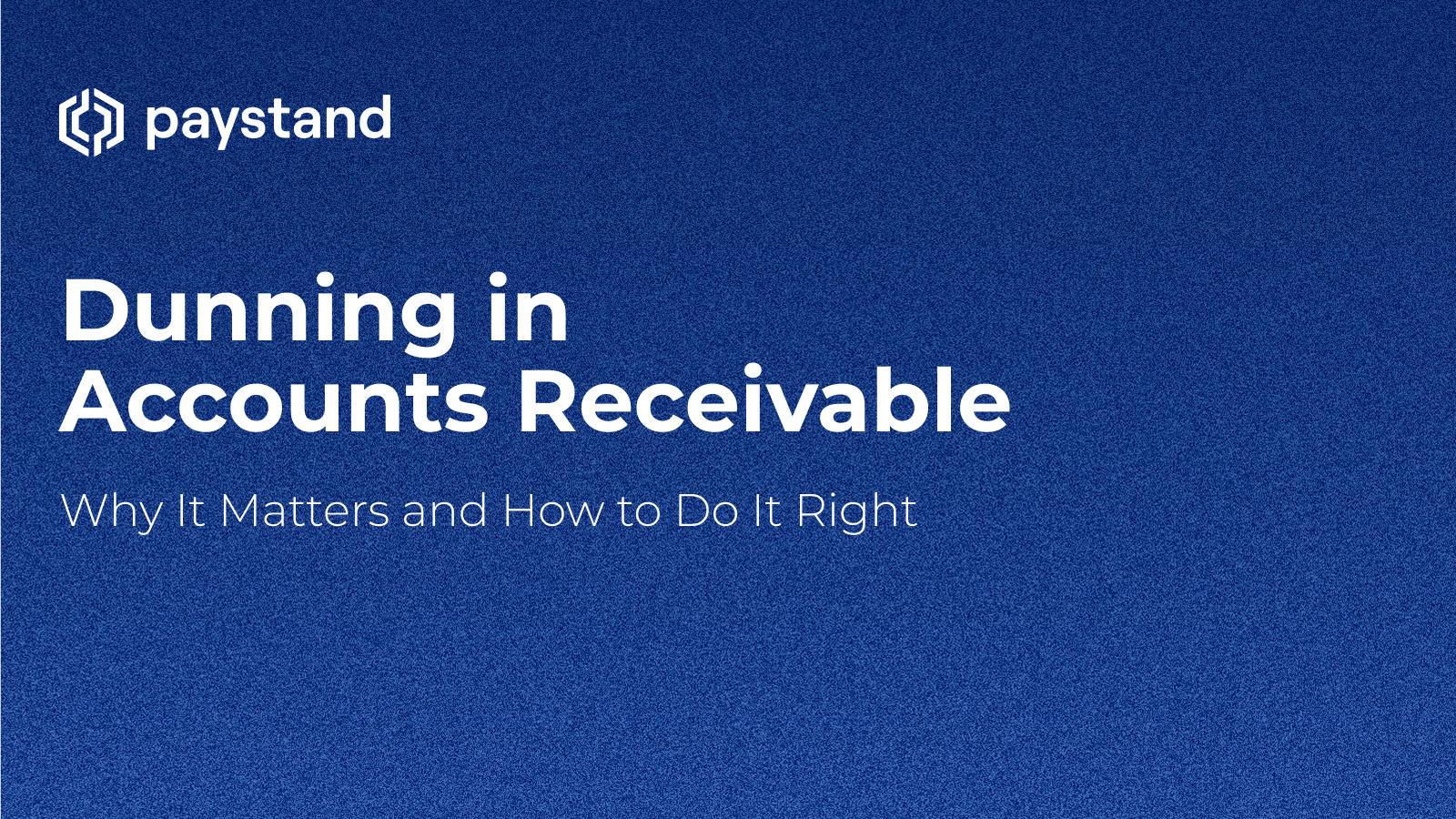Dunning in Accounts Receivable: Why It Matters and How to Do It Right

Table of Contents
- What Is Dunning in Accounts Receivable?
- Why Can Dunning Letters Be Harmful?
- What Are Common Mistakes in Dunning Accounts Receivable?
- Best Practices for Dunning in Accounts Receivable
- How Can You Improve Your Dunning Process?
- How to Automate Dunning Processes in Accounts Receivable
- Tools and Software Solutions That Can Help With Dunning in Accounts Receivable
- Final Thoughts
Key Takeaways
- Dunning is strategic, not just reminders, and when done right, it boosts cash flow and enhances customer trust.
- Tone, timing, and compliance are critical to avoid legal risks and maintain strong customer relationships.
- Automation and AI streamline collections by personalizing outreach and predicting late payments.
- The right AR tools accelerate results with multi-channel communication, payment options, and compliance features.
In our previous blog on dunning letters, we explored the basics of these collection notices and how they support the accounts receivable process. However, the topic goes much deeper when considering that poor dunning practices have financial, operational, and even legal implications.
This post dives into the larger picture of dunning in accounts receivable, answering essential questions about its definition, common pitfalls, risks to businesses, and how to build a more effective, automated dunning strategy that supports your payment process and improves customer relationships.
What Is Dunning in Accounts Receivable?
Dunning in accounts receivable refers to the process of systematically following up with customers who have overdue payments. This typically includes a series of emails, letters, or phone calls gently reminding the customer of their obligation to pay, and providing payment options to resolve the debt.
Effective dunning is more than just sending reminders. It’s a crucial part of your broader collection efforts, designed to reduce days sales outstanding (DSO), improve cash flow, and prevent bad debt accumulation. When executed seccesfully, it also plays a key role in maintaining strong customer relationships.
Why Can Dunning Letters Be Harmful?
Although dunning efforts are intended to encourage customers to pay on time, they can become harmful when misused. The risks include:
- Legal consequences: In the U.S., misuse of dunning letters can violate the Fair Debt Collection Practices Act (FDCPA). There have been numerous civil and criminal cases involving deceptive, aggressive, or misleading dunning communications.
Example: In Buchanan v. Northland Group, a settlement offer was sent for a debt past its statute of limitations. The court ruled it was misleading and violated the FDCPA.
The FTC has also taken action against companies using fraudulent dunning tactics, including fake threats of arrest and lawsuits. - Economic impact: Widespread abusive collection practices erode consumer trust, contribute to bankruptcies, and can harm credit markets. When customers are harassed or misled, they are less likely to engage or remain loyal.
- Business risk: A poor dunning process can lead to reputational damage, regulatory scrutiny, customer loss, and significant fines.
Put simply, when dunning letters are poorly timed, too aggressive, or non-compliant, they can do far more harm than good to the customer and your business.
What Are Common Mistakes in Dunning Accounts Receivable?
Missteps in your collection process can cost you in more ways than one. Here are some of the most common mistakes businesses make:
Generic or impersonal communication
Sending the same message to every customer, regardless of payment history or relationship, can damage customer trust.
Overly aggressive tone
Using threatening or fear-based language can violate legal regulations and alienate customers.
Ignoring compliance laws
Dunning communications must comply with the FDCPA and other financial regulations, especially if it operates across state lines.
Poor timing
Sending reminders too frequently or waiting too long can both be ineffective. There is a balance between being proactive and respectful.
Lack of payment options
If your payment strategy does not include easy ways for customers to pay, you create friction that delays resolution.
Best Practices for Dunning in Accounts Receivable
A proactive, respectful, and technology-supported dunning process can yield better outcomes. Here are some best practices to help you strengthen your dunning strategy:
- Use multi-channel communication: Combine email, text, and phone outreach to increase reach and responsiveness. Customers have different preferences, and flexibility improves engagement.
- Incorporate progressive escalation: Start with gentle reminders and escalate tone and urgency only if previous attempts fail. This protects customer relationships while still driving resolution.
- Provide self-service portals: Allow customers to view invoices, see their payment history, and make payments online. This reduces friction and empowers customers to resolve their own accounts.
- A/B test your messages: Experiment with different messaging styles, subject lines, and timing to see what drives better engagement and faster payments.
- Maintain a consistent tone: Keep your tone professional, courteous, and customer-friendly—even as reminders become more urgent.
- Log all activity: Keep detailed records of every dunning message sent and any customer responses. This helps ensure compliance and protects your business in the event of a dispute.
- Tailor by customer segment: Enterprise customers may expect a different communication style than small businesses. Adjust your messaging and cadence accordingly.
How Can You Improve Your Dunning Process?
The best dunning strategies are personalized, timely, and compliant. Here’s how to implement a more effective dunning process:
- Segment your customers: Customize dunning efforts based on customer history, payment behavior, and relationship status.
- Use empathetic language: Communicating with customers in a respectful, understanding tone helps preserve relationships.
- Offer flexible payment options: Make it easy for customers to pay with digital tools like credit cards, bank transfers, or scheduled installments.
- Optimize timing: Schedule dunning messages based on due dates and response windows—starting gently and escalating as needed.
- Monitor your metrics: Track performance KPIs like DSO, recovery rate, and average days overdue to evaluate the success of your efforts.
- Train your team: Ensure your AR and collections teams understand both the legal requirements and customer service expectations.
How to Automate Dunning Processes in Accounts Receivable
Manual dunning can be time-consuming, error-prone, and difficult to scale. Leveraging automation software within your AR management can improve accuracy, efficiency, and compliance.
Benefits of automating your dunning process include:
- Consistent messaging: Schedule reminders based on pre-defined workflows.
- Real-time payment tracking: Automatically update dunning efforts based on invoice status and payment history.
- Personalization at scale: Use customer data to tailor messages and offer relevant payment options.
- Audit trails: Maintain a transparent record of all communications for legal protection.
Tools and Software Solutions That Can Help With Dunning in Accounts Receivable
We have seen than leveraging an automation software not only boosts efficiency but also ensures legal compliance and helps reduce your DSO—freeing your team to focus on more strategic tasks, such as optimizing payment terms, improving customer segmentation, and using data to forecast cash flow more accurately.
Now let’s take a look at the features you should look for when evaluating an AR automation platform that will facilitate dunning and collections:
|
Feature |
How It Benefits Your Business |
|
Multi-channel follow-up |
Reach customers via email, SMS, and phone to improve response rates. |
|
Integrated payment options |
Make it easier to pay with zero-fee payment rails, ACH, or credit cards. |
|
Dispute tracking |
Quickly resolve payment issues and reduce delays. |
|
Cash application automation |
Apply payments accurately and instantly, improving efficiency. |
|
Analytics and reporting dashboards |
Gain real-time insights into AR performance and optimize collections. |
|
Easy-to-use customer portals |
Enable self-service payments, reducing back-and-forth communication. |
|
Security and compliance tools |
Protect sensitive data and ensure regulatory compliance. |
Modern AR automation platforms like Paystand make it easy to implement effective dunning sequences that integrate seamlessly into your payment process. These tools allow finance teams to automate reminders, track real-time payment activity, and personalize outreach at scale.
How AI Is Changing Dunning for the Better
AI can help you collect smarter, not harder—and it's only getting better. As artificial intelligence use in accounting continues to evolve, new tools are emerging to make dunning more intelligent and efficient. For example, AI-powered predictive analytics can now identify payment patterns to flag at-risk accounts before they become delinquent proactively. Natural language processing (NLP) enables systems to craft more empathetic and effective reminder messages tailored to customer behavior.
AI is also being used to suggest optimal send times for dunning messages based on historical engagement, and to classify incoming customer responses to route them for follow-up more efficiently.
Final Thoughts
Dunning in accounts receivable isn’t just about chasing payments. It’s about communicating with customers in a way that protects your brand, preserves relationships, and ensures long-term cash flow.
When done right, your dunning process can become a strategic tool to reduce overdue payments, lower DSO, and maintain trust. When done poorly, it opens the door to legal, financial, and reputational risks.
Eden Equipment transformed its AR process with Paystand. After switching from manual invoicing to a fully digital workflow, Eden reduced time spent chasing payments and accelerated collections. They went from waiting up to 30 days for checks in the mail to receiving 100% of payments digitally, some within 24 hours. By automating follow-ups and offering modern payment options, Eden improved internal efficiency while giving customers a faster, more professional payment experience. Explore our case study and discover how you can do the same.






